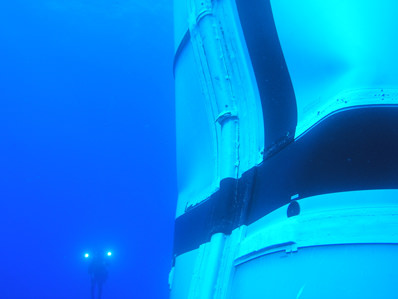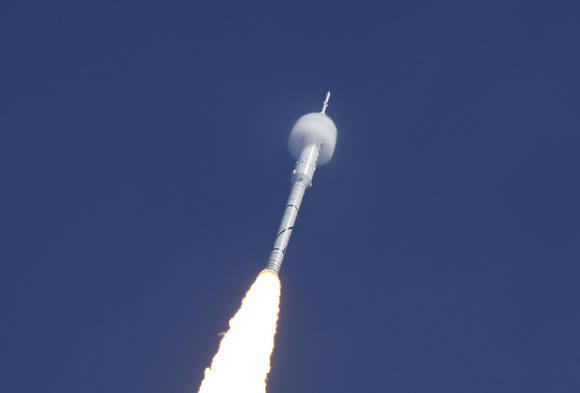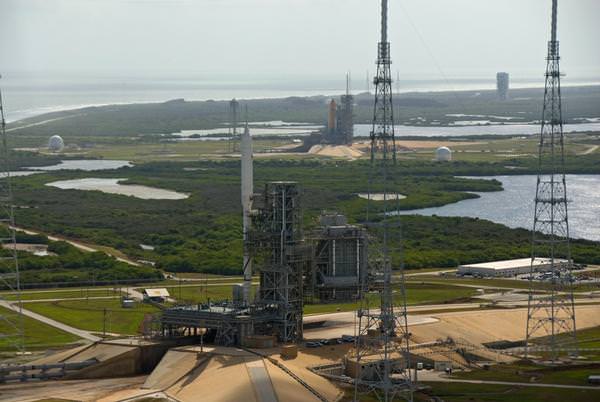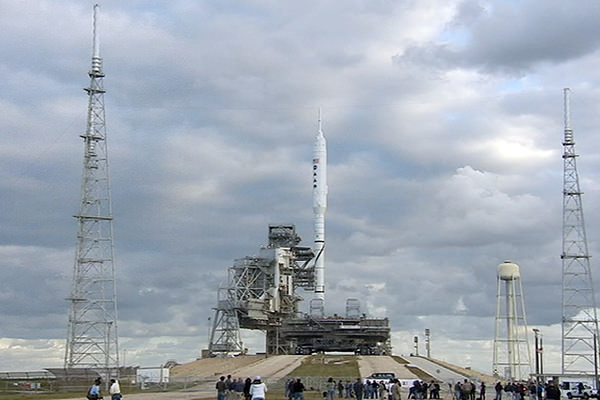Will the Ares rocket stay or will it go? For now, no one knows, but NASA engineers have developed multiple options for “de-tuning” the Ares I rocket to prevent any problematic thrust oscillations that could potentially expose astronauts to dangerous levels of vibrations as the rocket climbs to orbit with the Orion crew vehicle atop. Even though the Ares I-X test flight showed no problematic thrust oscillation vibrations took place during the flight, engineers believe they have found a solution to preclude it from actually ever happening with any future Ares rocket. Read the details below; and enjoy this video round-up of everything that happened with the Constellation program in 2009.
Continue reading “Engineers Find Fixes For Potential Thrust Oscillation Problem on Ares”
Chase Plane Footage of Ares I-X Flight
Here’s some great additional footage from the Ares I-X flight taken from a chase plane, which shows the entire flight, including booster separation and parachute deploy — and the problems that happened with the parachutes. The video was taken from a Cessna Skymaster aircraft positioned approx. 10 nautical miles away from the vehicle at an altitude of 12,000 feet. The videographer used a gyro-stabilized high-definition camera system mounted to the outside of the aircraft to capture this spectacular footage which provides extremely valuable engineering data, and imagery of the recovery sequence in rarely-seen detail. This provides NASA with additional critical data from vehicle ascent, booster deceleration and parachute deploy.
Continue reading “Chase Plane Footage of Ares I-X Flight”
Ares I-X Manager Addresses Booster Damage, Stage Tumbling and Thrust Oscillation
[/caption]
The damage seen on the Ares I-X booster occurred as a result of parachute failure, which caused the rocket to impact the water harder than expected. Ares I-X manager Bob Ess briefed reporters today on the preliminary data from Wednesday’s test flight of NASA new rocket, and said the parachute failure was not a significant event. “The damage we see is analogous to when there has been parachute failure on the space shuttle boosters, but actually the parachute guys were ecstatic overall and are not worried about it,” Ess said. “This is all part of doing a test flight, so team is still very elated. The fact that the parachute team has something interesting to go work makes them excited. The damage was all collateral because of the parachute.” He also touched on the “tumbling” of the second stage, and their findings on thrust oscillation for the vehicle.
Ess said all three chutes initially deployed as planned: pilot chute, then drogue chutes, then the three main chutes come out and partially deploy to a 50% open condition to avoid shock to the material. But at that point one of the mains failed and basically became a streamer. Ess said it appeared the lines went slack, which would be indicative of a problem with the riser lines and not the parachute material. Then a second chute may have gotten damaged from the bad “streamer” parachute and the second chute didn’t open all the way. So instead of coming down on three parachutes, it only had one and a half. “So that caused the booster to hit the water at a higher speed than expected, with more horizontal velocity, so booster slapped down pretty hard which caused damage on the booster.”
Additionally the booster was 15% heavier than the booster that will be used for Ares 1. “This was an overtest, so it does not detract from the success of the flight,” Ess said.

The tumbling seen as the two stages separated was actually not unexpected and Ess said he misspoke at the press briefing on the day of the test flight as the separation being “interesting” (and his team immediately let him hear about it!). “We’ve actually done thousands of animations showing this type of behavior on the upper stage, and the models predicted this is what we would see. It was the manager who didn’t say it right,” Ess joked.
The upper stage on the test flight was a “dummy” and was loaded with 30,000 pounds of ballast near the bottom to simulate a full load of liquid oxygen rocket propellant and another 30,000 pounds higher up to simulate liquid hydrogen fuel.
The center of gravity was in an unusual spot, making it inherently unstable, so it behaved exactly as a heavy, unstable projectile would. “Once you separate, there’s nothing to control it,” Ess said. “In reality, the Ares I will have the J-2X engine on it, and everything will be fine.”
The much ballyhooed thrust oscillations the vehicle might encounter were basically non-existent on Wednesday’s test flight. “We had two sensors to measure this and so far the oscillations look very small, similar to what the shuttle might encounter,” Ess said. “We didn’t see anything unusual or remotely like anything to indicate that thrust oscillation was a factor.”
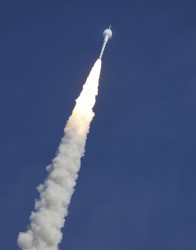
At Wednesday’s briefing, Ess said the vehicle has three pairs of thrusters to keep things under control if thrust oscillation would become a problem. Their simulations said they might encounter 20-25 firings of the automatic thrusters during flight, but in actuality, there were only three.
“We’re just not seeing any significant numbers for thrust oscillation,” Ess said. “It’s the impact on the vehicle that you worry about, and so far we haven’t seen it but we’ll look closer at the data in the next few weeks.”
The damaged booster contains the flight data recorder, and Ess thought they should get access to it on Saturday and begin looking at the data from over 700 sensors on board the vehicle.
Since test flights are done to bring up major problems, Ess was asked if he wished there were more issues to tackle. “It was a great flight, and the parachute problem is a minor thing, and we have a few more year to go look at it,” he said. “When something is a little different, you get excited, as an engineer. But we were ecstatic and no one is sad we didn’t have any more problems. We still have to look at the sensors, so there’s a lot in front of us. But there’s nothing pride from the team that it went as well as it did.”
Source: NASA press briefing
Ares I-X Booster Damaged
[/caption]
The booster rocket used in the Ares I-X test flight was found to be badly dented when divers located it in the Atlantic Ocean. The damage could have occurred as the booster hit the water. UPDATE (7:30 pm CDT): Bill Harwood from CBS news is reporting that according to NASA officials, one of the three 150-foot-wide parachutes designed to gently lower NASA’s Ares I-X first stage booster to the Atlantic Ocean deflated after deployment, resulting in a harder splashdown than expected. All three main chutes deployed, but while two inflated fully, the third collapsed. “A source said the deflated parachute contacted one of the others as it whipped about in the wind, causing a partial deflation. That could not be immediately confirmed, although a splashdown in that condition might explain the buckling seen in the lower segment of the rocket’s case,” Harwood wrote. (end of update).
Spaceflightnow.com reported that engineers have said shuttle boosters can be damaged depending on the impact angle and how rough the ocean is. But it’s not yet known whether such a “slap down” or some other issue might have caused the damage noted in the Ares I-X booster.
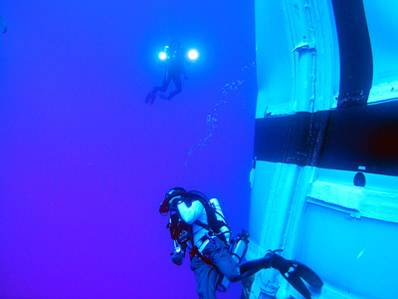
Parachute deploy was one of the major test objectives for the flight. The 327-foot-tall I-X rocket was equipped with a four-segment shuttle booster, a fifth segment loaded with avionics gear, a dummy upper stage and Orion crew module mockup.
The booster is being towed back to Kennedy Space Center, and should arrive late Thursday, where engineers will be able to look more closely at the damage.
Additionally, NASA is saying there was more damage to the launchpad following the Ares I-X launch than what is customarily seen after a shuttle launch. Leaks of toxic propellant at launch pad 39B forced NASA to evacuate the pad. Two separate leaks occurred at the 95-foot-level where the pad’s fixed service structure and gantry-like rotating service structure meet.
Meanwhile, on the shuttle side of the program, after a Flight Readiness Review, mission managers for the STS-129 mission have cleared space shuttle Atlantis to launch on Nov. 16 at 2:28 p.m. EST. The target date depends on the planned Nov. 14 launch of an Atlas V rocket from nearby Cape Canaveral Air Force Station. The Atlas has reserved the Eastern Range on Nov. 14 and 15. If the Atlas launch is delayed to Nov. 15, the shuttle’s liftoff will move to no earlier than 2:02 p.m. on Nov. 17.
The STS-129 mission will focus on storing spare hardware on the exterior of the space station. The flight will include three spacewalks and install two platforms on the station’s truss, or backbone. The platforms will hold spare parts to sustain station operations after the shuttle fleet is retired.
Also, the mission will bring up communications equipment for the SpaceX Dragon capsule and future commercial cargo missions to the ISS.
Sources: Spaceflightnow.com, NASA
Ares I-X Launch Image Gallery
[/caption]
There are some great images of Wednesday’s Ares I-X launch. Most notable is this one of the Prandtl–Glauert singularity bow shock that formed around the 327-foot-tall rocket as it went supersonic at about 39 seconds into the flight. Liftoff of the 6-minute flight test from Launch Pad 39B at NASA’s Kennedy Space Center in Florida was at 11:30 a.m. EDT Oct. 28. This was the first launch from Kennedy’s pads of a vehicle other than the space shuttle since the Apollo Program’s Saturn rockets were retired. See more great images below.
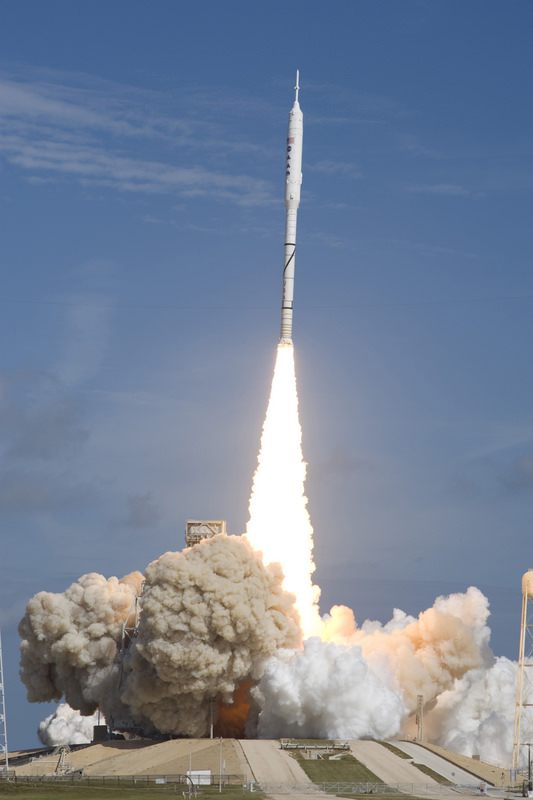
With more than 12 times the thrust produced by a Boeing 747 jet aircraft and 23 times the power output of the Hoover Dam, the Ares I-X test rocket produces 2.96 million pounds of thrust at liftoff. Interestingly, the Ares I-X booster was put together with parts from shuttle boosters that flew on 30 different shuttle missions ranging from STS-29 in 1989 to STS-106 in 2000. Ares I-X weighed 1.8 million pounds, almost twice that of a full 747 airliner.
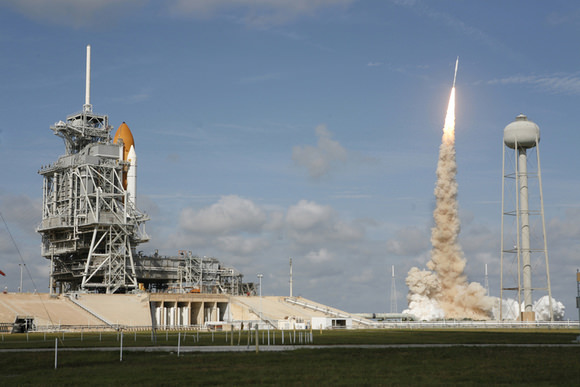
KSC is a busy spaceport, with the Ares I-X launching and space shuttle Atlantis poised on Launch Pad 39A for liftoff, targeted for Nov. 16. The Ares 1-X is nearly 143 feet taller than the space shuttle stack.
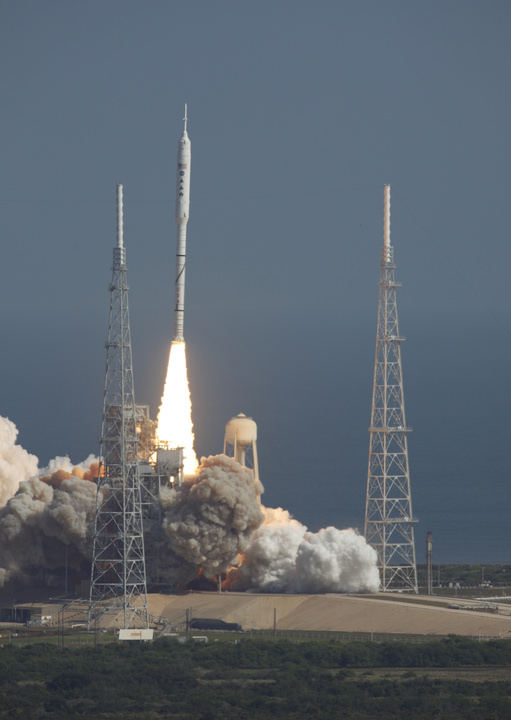
The data returned from more than 700 sensors throughout the rocket will be used to refine the design of future launch vehicles and bring NASA one step closer to reaching its exploration goals.
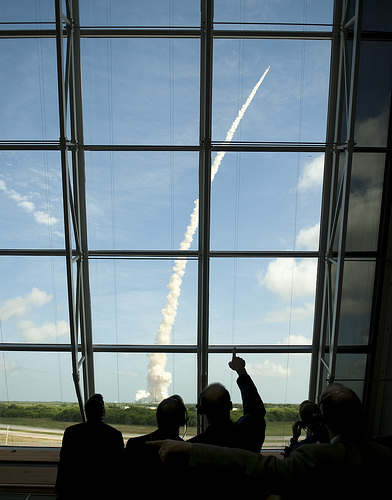
NASA Ares I-X mission managers watch from mission control as the Ares I-X rocket launches.
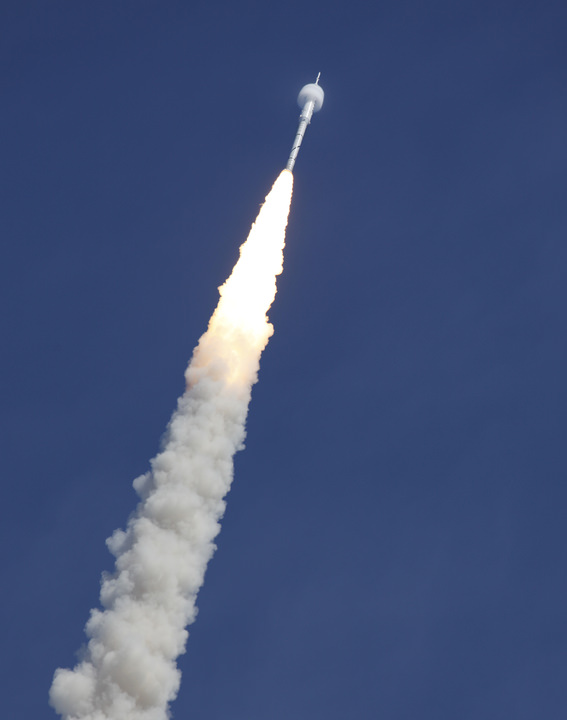
Here’s the full shot from the lead image showing the Prandtl–Glauert singularity, and here’s Wikipedia’s definition:
“The Prandtl–Glauert singularity or P.G. singularity is sometimes referred to as a vapor cone, shock collar, or shock egg.
The point at which a sudden drop in air pressure occurs is generally accepted as the cause of the visible condensation cloud that often surrounds an aircraft traveling at transonic speeds, though there remains some debate. It is an example of a mathematical singularity in aerodynamics.”
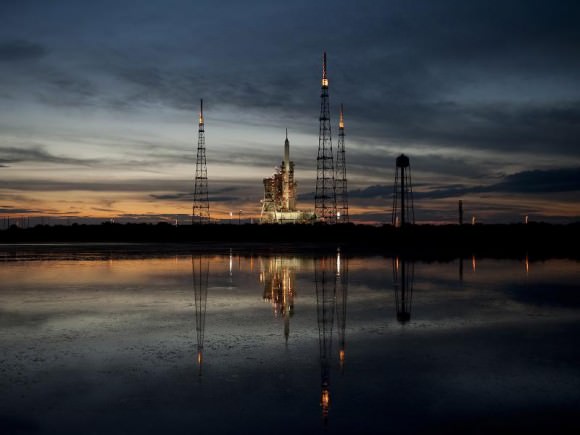
This is a gorgeous shot of the Ares I-X on the pad on an evening before launch.
For information on the Ares I-X vehicle and flight test, visit NASA’s website.
Arex I-X Launches Successfully
After waiting out weather and triboelectrification issues, the Arex I-X rocket thundered and crackled away from the launch pad at 11:30 am EDT with a successful (and beautiful) launch. The vehicle ran through the entire 2-minute test flight with no obvious problems or issues, ending with the stages separating and parachuting down to the Atlantic Ocean. This marks the first time a new vehicle has launched from Kennedy Space Center since the first space shuttle launch in 1981. “The only thing we were waiting for was weather,” said a jubilant test flight director Ed Mango to his team after the flight, “and that means all of you did fricking fantastic!”
[/caption]
“I can’t tell you how unbelievable that was,” said former astronaut Bob Cabana, who is now the director of Kennedy Space Center. “I got tears in my eyes. That was one of the most beautiful rocket launches I’ves seen. Given that three years ago this program was a blank piece of paper, it shows what we can do with common goal and common vision, I just couldn’t be more pleased.”
Constellation program manager Jeff Hanley said, “How impressive is that? You have all accomplished a great step forward for Constellation.”
Despite ongoing problems with the clouds and possible rain, the launch team worked closely with weather personnel to find a break in the clouds.
At the T+2 minute point in the flight, the upper stage simulator and first stage separated approximately 130,000 feet over the Atlantic Ocean. The unpowered simulator splashed down in the ocean, and the first stage was fired for a controlled ocean landing with parachutes so that it could be recovered.
Data collected from over 700 sensors on board the Ares I-X will help with the development of future missions as well as the design and modeling of future vehicles.
More images and video will be posted as they become available.
Ares I-X Launch Scrub: Can You Say Triboelectrification?
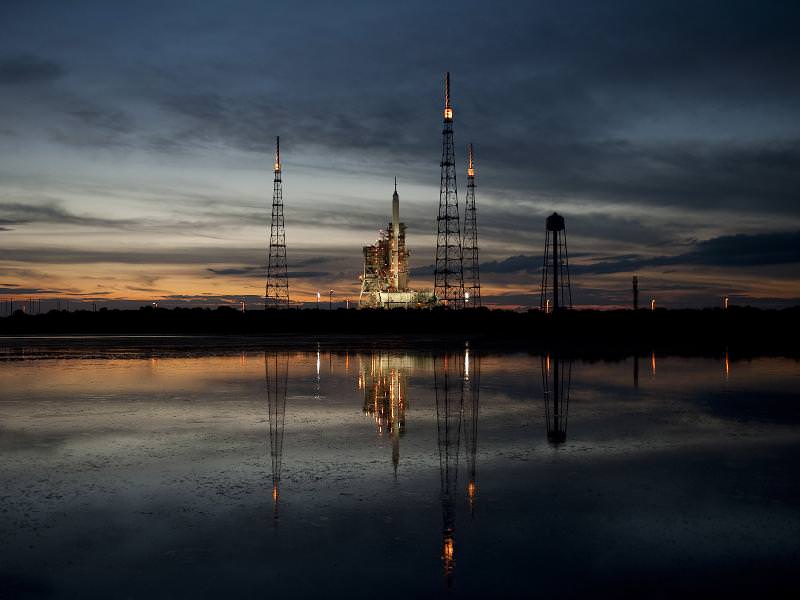
[/caption]
The test flight for the Ares I-X rocket was scrubbed on Tuesday after a roller coaster of repeated delays which included weather, a stuck cover on a probe, a cargo ship straying into the launch hazard zone, weather, and weather. “We had some opportunities, but just couldn’t get there,” launch test director Ed Mango said to the team. “Weather didn’t cooperate.” The biggest issue with weather was the launch commit criteria of avoiding possible static discharge called “triboelectrification” created by the outer coating of the rocket rubbing against cloud vapor or precipitation that is colder than -10 degrees C (14 deg. F). This static electricity could disrupt the transmission of flight test data from the rocket, and getting data is one of the main desired outcomes for the test flight.
Another 4-hour launch window opens at 8 am EDT (1200 GMT) on Wednesday.
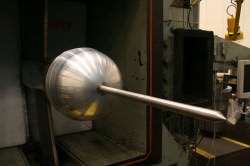
On Tuesday, when the weather improved enough to remove the 5-hole probe cover, then came a problem with removing it. This difficulty was not anticipated.
“After hundreds of tests with the probe, that’s the first time we’ve seen that failure mode,” said NASA engineer Jon Cowart on NASA TV. On Twitter, a NASA engineer shared that they gave the pad crew the recommendation to pull the lanyard attached to the cover “as hard as you can.” It worked.
Then came a cargo ship that entered the hazard area in offshore waters. The ship was notified and it turned around quickly.
But by that time the weather had deteriorated. Good on their word that they could quickly restart the countdown clock, the launch team tried several times to coordinate a hole in the clouds with acceptable (less than 20 knots) ground and upper level winds. It was a roller coaster of “go” and “no-go,” but ultimately the weather cards never fell into the fight configuration to allow the launch to take place.
Tomorrow the weather is better but not great. The chance of unacceptable conditions drops to 40% no go for Wednesday, as opposed to 60% no go today. Forecasters predict somewhat quieter winds at ground level, upper level winds are expected to be lighter and clouds will be decreasing, with more breaks in the clouds.
The test flight will last six minutes from liftoff to splashdown, with the Ares I-X reaching a maximum altitude of 46,000 m (153,000 feet) and a top velocity more than 4.7 times the speed of sound.
And if you are still wondering about triboelectrification, it basically is static electricity such as what you might encounter when you rub a balloon on your shirt, or rub your feet on a dry carpet or brush up against a cat and then touch a metal surface. Zap!
In the case of Ares I-X, flying through high-level clouds can generate “P-static” (P for precipitation), which can create a corona of static around the rocket that interferes with radio signals sent by or to the rocket. This would create problems when the rocket tries to transmit data down to the ground or if the Range Safety Officer at Cape Canaveral Air Force Station needed to send a signal to the flight termination system (a.k.a. blow up the rocket because of a big problem.)
Weather Only Issue for Ares I-X Test Flight
[/caption]
The Ares I-X and the space shuttle on the launchpads at KSC. Credit: NASA. Click for larger version.
Possible rain and high clouds are the only “ifs” so far for the test flight of the Ares I-X rocket on Tuesday morning, the first test flight of a new rocket for NASA in over 30 years. Central to the concern about weather is a possible static discharge called “tribo electrification” created by the outer coating of the rocket if it flies through cloud vapor or precipitation that is colder than -10 degrees C (14 deg. F). This static electricity could disrupt the transmission of flight test data from the rocket, one of the main reasons for the test. At a briefing Monday morning, managers for the Ares program said the only other issue they are working with also deals with weather – the timing when to remove a probe cover.
“There are no issues we are currently working,” said Bob Ess, Ares I-X mission manager. “We’ve worked through all the technical issues and it is relatively unprecedented to have a vehicle this clean for this long. Right now we’re just making sure test team is ready. The probe cover is not a new problem; we want to be smart and protect ourselves for when we take it off, because once you take it off you can’t put it on.”
The probe is covered by a “sock” that is Velcroed over the cover. The cover has to be removed manually by pulling a lanyard attached to the cover. If the cover is taken off and it starts to rain, water could get inside, freeze and cause problems with the probe. This doesn’t cause any issues of the vehicle being able to fly, but could cause issues with taking and receiving data.
The probe is part of over 700 sensors for the flight.
The launch window opens at 8 am EDT (1200 GMT), but managers said they can use the entire four-hour window if necessary. $445 million test flight will last six minutes from liftoff to splashdown, with the Ares I-X reaching a maximum altitude of 46,000 m (153,000 feet) and a top velocity more than 4.7 times the speed of sound.
NASA weather officer Kathy Winters said there is a chance of isolated showers, not widespread, but clouds could be a problem. Currently Winters reports a 40% chance of favorable weather for Tuesday. If a 24 hour delay is called, the weather improves to 60% chance of good weather on Wednesday and 70% on Thursday.
“This is a test flight, and not human flight, so there’s not the level of redundancy and the amount analysis if it was,” said Ess. “There are no guarantees, but we have high confidence in the vehicle. We know we’ll learn a lot from this.”
Ess said the main data they will be looking for is that the stage separation occurs at the altitude and speeds that are expected from computer models. “We’ll be receiving data during the flight,” Ess said, “and we’ll get a data recorder back when we recover the booster. We’ll get a huge amount of data from the recorders and compare it with ground station tracking. We’ll merge two different data sets, to get the ‘best of source,’ as its called — get the cleanest , data we can get. That takes a couple of weeks. We have scheduled to give 30-, 60- and 90-day reports, and will be looking through sensor data for any surprises. We have computer models what we expect to see.”
Top of their list of things to look for are information about thrust oscillation issues which have been reported to be a potential show stopper for the Ares program, as well as monitoring acoustics and other pressure sensors. “It will be a long process to go through the large amount of data we’ll be getting” Ess said.
Over 200 sensors will measure how vehicle will bend and stretch throught the various parts fo the flight. They are also interested in seeing how robust the parachute deployement sequence is. A large amount of that data will be gathered through imagery by a chase plane.
When asked about the possibility of this being the only flight for Ares – since the Augustine Commission Report seems to hint at a possible future without the Ares 1 vehicle, Constellation program manager Jeff Hanley said, “What is most critical is that we learn something, and what does it mean for generations coming up. Key for future of human spaceflight is to have tools that allow us to go places we’ve never gone before, and we need substantial tools in our tool kit… What you see in Ares I-X is a stepping stone along the way. With any other architecture we’d be following a similar approach. Whatever the nation asks us to do, the Ares I-X demonstrates a lot of learning.”
Source: NASA press briefing
Ares I-X Test Flight is Go For Oct. 27 (Video)
Following a flight test readiness review, NASA has given the ‘all systems go’ for the Ares I-X maiden test flight on Tuesday, Oct. 27, at 8 a.m. EDT from NASA’s Kennedy Space Center in Florida. “I am proud of the work this team has done to ready this test rocket for launch,” said Doug Cooke, associate administrator for NASA Exploration Systems Mission Directorate. “This test will yield important data to support the nation’s next steps in exploration. There is no substitute for hard data – flight testing clarifies the distinction between imagined outcomes and real flight experience.”
This is the first time in more than 30 years that NASA has built a vehicle in a new configuration. The uncrewed test flight last two minutes, and go 45 kilometers (28 miles) in altitude. The stages will separate 69 km (43 miles) down range and end 236 km (147 miles) over the Atlantic Ocean, with the dummy upper stage landing in the ocean.
The flight will be broadcast on NASA TV. Watch it online here. In the meantime, here’s a pre-launch video to whet your appetite for a new rocket.
Ares I-X at the Launchpad
[/caption]
“The Stick” made it out to launchpad 39B without falling over. I have to admit, NASA’s new rocket looked tall, super-skinny and pointy (as Dr. Brian Cox described it), as it rolled out on the crawler transporter. Somehow, it seems the Ares I-X should be wider. It’s definitely tall — at 100 meters (327 feet,) it is 43 meters (143 feet) taller than the space shuttle. But appearances aside, this is an historic occasion. For the first time in more than a quarter century, a new vehicle is sitting out at the launchpad at Kennedy Space Center in Florida.
More pictures below:
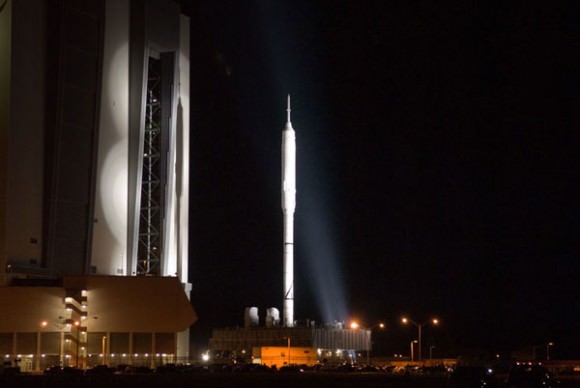
The Ares I-X flight test vehicle arrived at the pad at approximately 7:45 a.m. EDT Tuesday. The crawler-transporter left Kennedy’s Vehicle Assembly Building at 1:39 a.m., traveling less than 1 mph during the 4.2-mile journey. The rocket was secured “hard down” on the launch pad at 9:17 a.m.
The test flight of the Ares I-X rocket is scheduled to launch at 8 a.m. on Oct. 27. This test flight will provide NASA an opportunity to test and prove hardware, models, facilities and ground operations associated with the Ares I launch vehicle. Mission managers will finalize the launch date at a flight readiness review on October 23.
And in case you aren’t familiar with what the Ares I-X is for, the test flight will check out this un-crewed, modified Ares I configuration with a sub-orbital development test that will launch the rocket 43 km (28 miles) in altitude. This is the first developmental flight test of the Constellation Program, which includes the Ares I and V rockets, Orion and the Altair lunar lander.
Unless it all gets axed. The Augustine Report comes out on October 22.
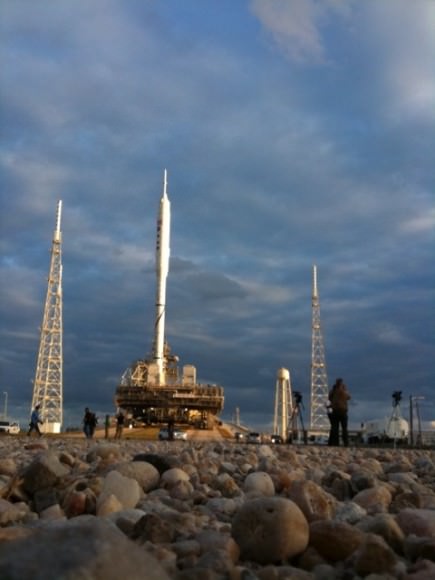
For more great images of Ares I-X, checkout Robert Pearlman’s collection of rollout pics over at collectSPACE, or Spaceflightnow.com’s gallery of Ares I-X images from this morning.

